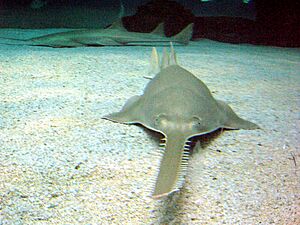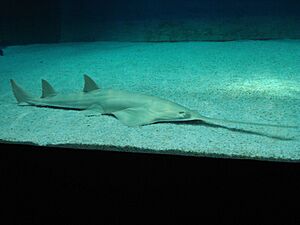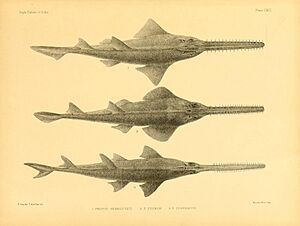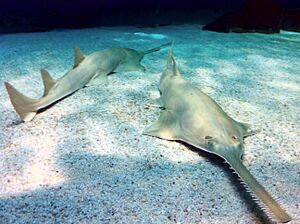Longcomb sawfish facts for kids
Quick facts for kids Longcomb sawfish |
|
|---|---|
 |
|
 |
|
| Conservation status | |
| Scientific classification |
The longcomb sawfish, also known as the narrowsnout sawfish or green sawfish (Pristis zijsron), is a special type of sawfish. It belongs to the family called Pristidae. You can find these amazing fish in the warm, tropical and subtropical waters of the Indo-West Pacific region. Sadly, their numbers have dropped a lot, and they are now considered a critically endangered species. This means they are at a very high risk of disappearing forever.
Contents
What Does the Longcomb Sawfish Look Like?
The longcomb sawfish might be the biggest sawfish species! It can grow up to about 7.3 meters (24 feet) long. However, today it's rare to see one longer than 6 meters (20 feet). Its back is usually a greenish-brown or olive color, while its belly is whitish.
It has a unique "saw" or snout with many teeth. To tell it apart from other sawfish, you can look for these features:
- Its saw has teeth almost all the way to its base.
- There are 23 to 37 teeth on each side of its saw.
- The teeth near the tip of the saw are closer together than those at the base.
- Its saw is quite narrow, usually 9–17% of its length.
- The saw itself is long, making up 23–33% of the fish's total length.
- It has short pectoral fins (the fins on its sides).
- Its first dorsal fin (the fin on its back) starts behind its pelvic fins (the fins on its belly).
- It has a very small or no lower tail fin lobe.
These special features help scientists identify the longcomb sawfish from its relatives, like the dwarf sawfish or the smalltooth sawfish.
Where Do Longcomb Sawfish Live?
The longcomb sawfish lives in warm, tropical and subtropical areas of the western and central Indo-Pacific Ocean. In the past, they lived in a huge area, almost 5.9 million square kilometers (2.3 million square miles)! Their range stretched from South Africa, up to the Red Sea and Persian Gulf, and east through Southeast Asia all the way to Australia. In Australia, they were found from Shark Bay along the northern coast, down to Jervis Bay on the eastern side.
Sadly, they have disappeared from many parts of their old home. Today, they are only found in a much smaller area. They can live in slightly cooler waters than other sawfish, which is why they used to be found further south in Australia.
These sawfish mostly live in coastal ocean areas, mangrove forests, and estuarine habitats (where rivers meet the sea). They can even be found in very shallow water. Sometimes, they swim far out into the ocean, reaching depths of over 70 meters (230 feet). While there are a few records of them in rivers far inland, they don't usually live in freshwater. They prefer places with sandy, muddy, or silty bottoms.
Behavior and Life Cycle
Longcomb sawfish eat other fish, crustaceans (like crabs), and molluscs (like snails). They use their long, toothed "saw" to find food. They thrash their saw from side to side to dig up prey from the seabed or to stun groups of fish. Sawfish are generally harmless to humans. However, if they are caught, they can cause serious injuries while trying to defend themselves with their saw.
Not much is known about their life cycle. We do know that they are ovoviviparous. This means the mother carries the eggs inside her body until they hatch, and then she gives birth to live young. Baby sawfish are born about 60–108 centimeters (24–43 inches) long. It's often said that a mother has about 12 babies at a time, but scientists are still learning about this. In other sawfish species, the number of young can range from 1 to 20.
Female sawfish give birth in areas close to the shore. The young sawfish stay near the coast and in estuaries during the first part of their lives. They become old enough to have their own babies at around 9 years old, when they are about 3.4–3.8 meters (11–12.5 feet) long. We don't know how long they live in the wild, but it might be more than 50 years. One sawfish that was caught as a young fish lived for 35 years in an aquarium!
Conservation Efforts
The longcomb sawfish population has dropped dramatically. Because of this, the IUCN (International Union for Conservation of Nature) has listed it as "Critically Endangered" on its Red List of Threatened Species. This means it's very close to extinction.
The main reason for their decline is fishing. Their fins are highly valued for shark fin soup, and their saws are sold as unique items. Some parts of the sawfish are also used in Asian traditional medicine, and their meat is eaten. Sawfish are especially likely to get caught in fishing nets because of their long, toothed saws. When they are accidentally caught, fishers sometimes kill them before bringing them onto the boat because their saw can be dangerous.
Their homes are also disappearing. Coastal areas, mangroves, and estuaries, which are important nurseries for young sawfish, are being destroyed or damaged. For example, about 30% of mangrove areas in Southeast Asia have been lost since 1980. New coastal developments, like mining operations and oil and gas extraction, also threaten their habitats. These developments can create structures like lighted jetties and dredged shipping channels, which might make it harder for young sawfish to move along the coast. This could break up their populations or destroy important places where young sawfish grow up.
Historically, longcomb sawfish were found in 37 countries. Now, they have completely disappeared from 2 countries and possibly from another 24. This leaves only 11 countries where they are definitely still alive. This means they only survive in about 62% of the area they used to live in. Scientists believe their total population has shrunk by more than 80% over the last three generations.
The sawfish populations in Australia are some of the few that are still doing okay, but even they have declined. For example, they no longer live in New South Wales. The longcomb sawfish has some protection in countries like Australia, Bahrain, Bangladesh, India, Indonesia, Malaysia, Qatar, and the United Arab Emirates. However, it's often hard to enforce these fishing rules. All sawfish species are also listed on CITES Appendix I. This international agreement helps control and restrict the trade of endangered animals.
Longcomb sawfish don't have many natural enemies, but large sharks and crocodiles might sometimes hunt them.
A few longcomb sawfish are kept in public aquariums. In 2014, there were 13 in North America. In 2013, there were 6 in Europe, and in 2017, there were 2 in Japan. These aquariums help scientists learn more about them and raise awareness about their conservation.
See also






